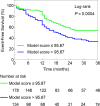A nomogram risk prediction model for ischemic mitral regurgitation after primary percutaneous coronary intervention in patients with ST-segment elevation myocardial infarction
- PMID: 40317080
- PMCID: PMC12048939
- DOI: 10.1186/s40001-025-02624-1
A nomogram risk prediction model for ischemic mitral regurgitation after primary percutaneous coronary intervention in patients with ST-segment elevation myocardial infarction
Abstract
Aim: This study developed a nomogram to predict the risk of ischemic mitral regurgitation (IMR) after percutaneous coronary intervention (PCI) in patients with ST-segment elevation myocardial infarction (STEMI) patients and evaluate their long-term prognosis.
Methods: Data from 342 STEMI patients were collected. Logistic regression identified independent risk factors for IMR during hospitalization, while Cox regression assessed risk factors during follow-up. The nomogram was developed based on these factors. ROC evaluated its predictive value, and decision curve analysis/clinical impact curves assessed clinical utility. Kaplan-Meier analysis evaluated the model's prognostic value.
Results: The independent risk factors for hospitalized IMR after PCI in STEMI patients included Gensini score (OR 1.009; P = 0.047), left ventricular ejection fraction (LVEF) (OR 0.941; P = 0.007), albumin (OR 0.941; P = 0.046), and systemic immune-inflammatory index (SII) (OR 1.096; P < 0.001). During follow-up, diabetes mellitus (HR: 1.154; P = 0.019), hemoglobin (HR: 0.991; P = 0.028), Gensini score (HR: 1.007; P = 0.022), LVEF (HR: 0.972; P = 0.015), and SII/100 (HR: 1.034; P < 0.001) were identified as independent predictors of IMR. The nomogram showed strong clinical benefit, good calibration, and predictive value. Patients with lower scores had better long-term outcomes.
Conclusion: This nomogram effectively predicts the occurrence of IMR after PCI in STEMI patients, providing valuable prognostic insights.
Keywords: Major adverse cardiovascular events; Mitral regurgitation; Nomogram; Prognosis; ST-segment elevation myocardial infarction.
© 2025. The Author(s).
Conflict of interest statement
Declarations. Ethics approval and consent to participate: The research was carried out in compliance with the Declaration of Helsinki and granted approval by the Joint Logistics Support Force of the Chinese People's Liberation Army, 904 Hospital Ethics Committee, Wuxi, China (Clinical trial number: 20240405). Written informed consent was obtained from all patients, allowing for the retrospective utilization of their de-identified data for health-related research purposes. Consent for publication: Not applicable. Competing interests: The authors declare no competing interests.
Figures







Similar articles
-
A Predictive Model for Contrast-Induced Acute Kidney Injury After Percutaneous Coronary Intervention in Elderly Patients with ST-Segment Elevation Myocardial Infarction.Clin Interv Aging. 2023 Mar 22;18:453-465. doi: 10.2147/CIA.S402408. eCollection 2023. Clin Interv Aging. 2023. PMID: 36987461 Free PMC article. Clinical Trial.
-
Construction and evaluation of nomogram model for individualized prediction of risk of major adverse cardiovascular events during hospitalization after percutaneous coronary intervention in patients with acute ST-segment elevation myocardial infarction.Front Cardiovasc Med. 2022 Dec 21;9:1050785. doi: 10.3389/fcvm.2022.1050785. eCollection 2022. Front Cardiovasc Med. 2022. PMID: 36620648 Free PMC article.
-
Establishment and validation of a nomogram model containing a triglyceride-glucose index and neutrophil-to-high-density lipoprotein ratio for predicting major adverse cardiac events in patients with ST-segment elevation myocardial infarction.J Int Med Res. 2024 Sep;52(9):3000605241258181. doi: 10.1177/03000605241258181. J Int Med Res. 2024. PMID: 39291425 Free PMC article.
-
A nomogram risk prediction model for no-reflow after primary percutaneous coronary intervention based on rapidly accessible patient data among patients with ST-segment elevation myocardial infarction and its relationship with prognosis.Front Cardiovasc Med. 2022 Aug 8;9:966299. doi: 10.3389/fcvm.2022.966299. eCollection 2022. Front Cardiovasc Med. 2022. PMID: 36003914 Free PMC article.
-
Evaluation of a nomogram model for predicting in-hospital mortality risk in patients with acute ST-elevation myocardial infarction and acute heart failure post-PCI.Scand Cardiovasc J. 2024 Dec;58(1):2387001. doi: 10.1080/14017431.2024.2387001. Epub 2024 Aug 2. Scand Cardiovasc J. 2024. PMID: 39092557
References
-
- Hakgör A, Karaca O, Yazar A, et al. Percutaneous treatment of severe acute mitral regurgitation early after myocardial infarction and a short review of the literature. Turk Kardiyol Dern Ars Turk Kardiyol Dern Yayin Org. 2023;51(4):290–3. 10.5543/tkd.2022.09434. - PubMed
-
- Igata S, Cotter BR, Hang CT, et al. Clinical and echocardiographic predictors of reduced survival in patient with functional mitral regurgitation. Am J Cardiol. 2021;150:95–100. 10.1016/j.amjcard.2021.03.048. - PubMed
-
- Bursi F, Enriquez-Sarano M, Nkomo VT, et al. Heart failure and death after myocardial infarction in the community: the emerging role of mitral regurgitation. Circulation. 2005;111(3):295–301. 10.1161/01.Cir.0000151097.30779.04. - PubMed
-
- Moreira DM, da Silva RL, Vieira JL, et al. Role of vascular inflammation in coronary artery disease: potential of anti-inflammatory drugs in the prevention of atherothrombosis. Inflammation and anti-inflammatory drugs in coronary artery disease. Am J Cardiovasc Drug Drug Devices Interv. 2015;15(1):1–11. 10.1007/s40256-014-0094-z. - PubMed
-
- Swirski FK, Nahrendorf M. Cardioimmunology: the immune system in cardiac homeostasis and disease. Nat Rev Immunol. 2018;18(12):733–44. 10.1038/s41577-018-0065-8. - PubMed
MeSH terms
Grants and funding
LinkOut - more resources
Full Text Sources
Medical
Miscellaneous

